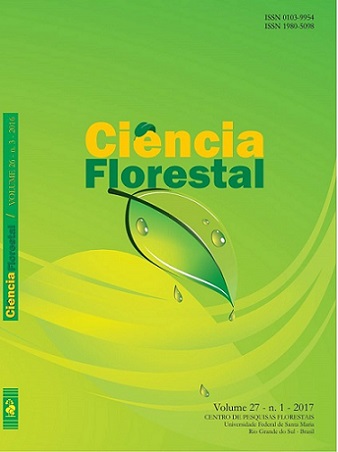DIAGNOSIS OF THE FORESTS PLANTED IN RIVER BASIN OF ‘PARDO’ RIVER, RIO GRANDE DO SUL STATE
DOI:
https://doi.org/10.5902/1980509826472Keywords:
family farming, forest inventory, Prodan method, forest economyAbstract
The present study aims to make a diagnosis of the forests planted in the basin of ‘Pardo’ river (Rio Pardo), in RS state, by contemplating the characterization of properties, of forestations, and of the availability and consumption of wood in the region. The area of reach of the study is in the central region of Rio Grande do Sul state, which main economy is the tobacco crop, enclosing 13 cities that compose the performance area of the Management Committee of Rio Pardo Hydrographic Basin. The data collect were conducted during year 2008. In order to determine the size of the sample, it was made a sampling with its probability proportional to the size, where the criterion of the sample unity distribution took in consideration the numbers of trees per city and, inside the cities, the number of trees per class of property size. The sampling method utilized on the forest inventory was by Prodan, in addition to interviews taken with the producers. The region is characterized by small agricultural producers, and 61.4% of the firewood used in the cure of tobacco leaves is acquired from others, moreover, the majority of the forestation possess reduced spacing (2.26 m²/plant) and low survival indices, in order of the 34.4% after 7 years of the plantation. The wooden current supply is of 2,781.069 m³, what guarantees a supplying for only 3.5 years. The collected data allow to evidence that the resources necessary to invest in the self-sufficiency of firewood for the crop tobacco, are of R$ 12,250,000,00, that could be placed annually, during seven years, equivalent the rotation in simple coppice, resulting in an area of 80 ha/year/city.
Downloads
References
ANDRAE, F. H. Ecologia florestal. Santa Maria, UFSM, 1978. 250p.
BARROS, M. V. Fator de cubicação para madeira empilhada de Eucalyptus grandis W. Hill ex Maden, com toretes de dois comprimentos, e sua variação com o tempo de exposição no ambiente. 2006. 103 p. Dissertação (Mestrado em Engenharia Florestal) – Universidade Federal de Santa Maria, Santa Maria, 2006.
BERGER, R. Crescimento e qualidade da madeira de um clone de Eucalyptus saligna Smith sob o efeito do espaçamento e da fertilização. 2000. 126 p. Dissertação (Mestrado em Engenharia Florestal) - Universidade Federal de Santa Maria, Santa Maria, 2000.
ETGES, V. E. Sujeição e resistência: os camponeses gaúchos e a indústria do fumo. Porto Alegre: FEE, 1989.
ETGES, V. E. A região no contexto da golabização: o caso do Vale do Rio Pardo. In: VOGT, O. P.; SILVEIRA, R. L. (Org.). Vale do Rio pardo: (re)conhecendo a região. Santa Cruz do Sul: Edunisc, 2001, p. 351-366.
FARIAS, J. A.; BIANCO, S. Reflorestamento: bom para o meio ambiente e para sua propriedade. Rio de Janeiro: Souza Cruz, 1999.
FERREIRA. C. A.; GALVÃO, A. P. M. Importância da atividade florestal no Brasil. In: GALVÃO, A. P. M. (Org.). Reflorestamento de propriedades rurais para fins produtivos e ambientais: um guia para ações municipais e regionais. Brasília: Embrapa Comunicação para Transferência de Tecnologia; Colombo: Embrapa Florestas, 2000. 351p.
FREY, M. R.; WITTMANN, M. L. Práticas de fomento florestal e incentivo à preservação das matas nativas na fumicultura. Redes, Santa Cruz do Sul, v. 12, n. 3, p. 99-117, 2007.
GOETZE, M.; THOMÉ, G. C. H. Efeito alelopático de extratos de Nicotiana tabacum e Eucalyptus grandis sobre a germinação de três espécies de hortaliças. R. Brasileira de Agrociência, Pelotas, v. 10, n. 1, p. 43-50, 2004.
GUIMARÃES, R. F. Ensaio de espaçamento em Eucalyptus saligna Sm. para produção de lenha. Serv. Flor. CIA Paulista Estrada Ferro Boi., 6. ed. 1961. 42 p.
IBDF - Instituto Brasileiro de Desenvolvimento Florestal. Inventário florestal nacional – reflorestamento Rio Grande do Sul. Brasília: IBDF, 1983. 182 p.
MÜLLER, I. Avaliação da produtividade da Acacia mearnsii De Wild. (Acácia negra) em função de diferentes espaçamentos. 2006. 131 p. Dissertação (Mestrado em Engenharia de Produção) - Universidade Federal de Santa Maria, Santa Maria, 2006.
PELLICO NETO, S.; BRENA, D. A. Inventário florestal. Curitiba: UFPR. 1997. 316 p.
PELLICO NETTO, S. Amostragem em dois estágios com unidades primárias de tamanhos diferentes. Ciência Florestal, Santa Maria, v. 6, n. 1, p. 147-155, 1996.
SCHNEIDER, P. R. et al. Produção de madeira para energia de Eucalyptus grandis em diferentes espaçamentos na região de Rio Pardo, Rio Grande do Sul, Brasil. In: 3º SIMPÓSIO LATINO-AMERICANO SOBRE MANEJO FLORESTAL, 2004, Santa Maria. Anais... Santa Maria: UFSM/CCR/PROGRAMA DE PÓS-GRADUAÇÃO EM ENG. FLORESTAL, 2004. p. 1-6.
SEMA – RS, 2003. Disponível em: <http://coralx.ufsm.br/ifcrs/frame.htm.> Acesso em 02 de agosto de 2009.
SEMA – Secretaria Estadual do Meio Ambiente do RS. Inventário florestal contínuo. Porto Alegre: UFSM /
SILVA, H. D.; BELLOTE, A. F. J.; FERREIRA, C. A. Cultivo do eucalipto. Colombo: Embrapa Florestas, 2003.
SILVA, J. C. . Eucalipto: desfazendo Mitos e Preconceitos. Revista da Madeira, Curitiba, 63. ed., p. 52-56, 2003.
TONIETTO, L.; STEIN, P. P. Silvicultura da Acácia negra (Acacia mearnsii De Wild.) no Brasil. Florestar Estatístico, São Paulo, v. 4, n. 12, p. 11-16, 1997.
VOGT, O. P. Produtor integrado: um apêndice da exploração industrial. In: Centro de Estudos Marxistas. Os trabalhos e os dias: ensaios de interpretação marxista. Passo Fundo: UPF, 2000. p. 163-179







